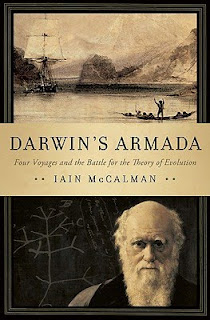As we enter the critical book buying season (hint-hint), I would like to recommend two recent books. Both focus on science and even better perfectly complement each other. They would make a nice pair of presents for anyone interested in understanding science and the passions that drive scientists. The books are Darwin’s Armada: Four Voyages and the Battle for the Theory of Evolution by Iain McCalman and The Age of Wonder: How the Romantic Generation Discovered the Beauty and Terror of Science by Richard Holmes. Holmes’ book came out in 2008 and McCalman’s in 2009.

Dense, yet readable, Age of Wonder focuses on what Holmes calls the second scientific revolution, inspired by novel developments in astronomy and chemistry. (The first revolution centered around Newton.) Holmes book ends his period around two legendary voyages: James Cooks’ round-the-world expedition started in 1768 and Charles Darwin’s voyage in the HMS Beagle, which ended in 1836. It was a period of brilliant insights, dangerous experimentation with electricity and nasty chemicals, and lone scientists devoted to pushing the frontiers of their subjects.
Holmes does an excellent job of detailing the lives of his vast cast of characters, which ranges from chemist Humphry Davy to astronomer William Herschel to novelist Mary Shelley to explorer Mungo Park (what a cool name to have!). In presenting Herschel and his work, Holmes clearly shows how Herschel, the man who found Uranus (the first planet discovered in more than 1,000 years), couldn’t have succeeded without his equally talented sister Caroline. Davy also stands out for his work with laughing gas, development of a safe, underground mining lamp, and popular lectures on science, which drew hundreds. In addition, Holmes interfingers the science with poetry through the work of Samuel Coleridge and William Wordsworth.

Coincidentally, Darwin’s Armada picks up exactly where Age of Wonder stops. McCalman details the formative voyages and expeditions of Darwin, botanist Joseph Hooker, Thomas Huxley, and Alfred Russell Wallace. Less dense and a bit lighter in tone, Armada shows how their work in the southern hemisphere shaped each man’s understanding of science and the natural world and in turn led them down the paths to insights into evolution. And once on those paths, these four men were the prime movers in discussing, debating, and fleshing out natural selection. McCalman also shows how the four became deep friends who helped each other through scientific, family, and financial challenges.
In reading each of these books, I was constantly amazed to see the excitement of new discoveries but also the dangers of working with new materials and visiting wild places. It is a wonder at times that any of the great scientists discussed here didn’t die young. We are fortunate they didn’t and fortunate that they come to life in the pages of these two fine books.